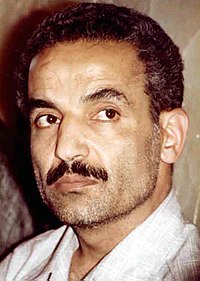Abolished administration of Mohammad-Javad Bahonar (1981)
This article needs additional citations for verification. (February 2010) |
Mohammad-Ali Rajai | |
|---|---|
 | |
| President of Iran | |
| In office August 15, 1981 – August 30, 1981 | |
| Prime Minister | Mohammad-Javad Bahonar |
| Leader | Ruhollah Khomeini |
| Preceded by | Abolhassan Banisadr |
| Succeeded by | Ali Khamenei |
| Personal details | |
| Born | June 15, 1933 Ghazvin, Iran |
| Died | August 30, 1981 (aged 48) Tehran, Iran |
| Political party | Islamic Republican Party |
| Spouse | Ateghe Sediqi (1958-1981) |
Mohammad-Javad Bahonar محمد جواد باهنر | |
|---|---|
| File:Mohammad javad Bahonar.jpg | |
| Prime Minister of Iran | |
| In office August 15, 1981 – August 30, 1981 | |
| President | Mohammad Ali Rajai |
| Leader | Ruhollah Khomeini |
| Preceded by | Mohammad Ali Rajai |
| Succeeded by | Mohammad Reza Mahdavi Kani |
| Personal details | |
| Born | 1933 Kerman, Iran |
| Died | August 30, 1981 Tehran, Iran |
| Political party | Islamic Republican Party |
The Government of Mohammad-Javad Bahonar was the second government of Iran after the Iranian Revolution. During that time, Mohammad-Ali Rajai was president and Mohammad-Javad Bahonar was prime minister.
Rajai's Presidency
On August 15, 1981, Rajai was elected as second president of Iran. He introduced Mohammad-Javad Bahonar as prime minister to parliament and parliament voted him. Rajai was the President of Iran for 15 days. He started the Iranian retirement program for individuals over the age of 70. On August 30, 1981, President Rajai held a meeting of Iran's Supreme Defense Council, along with Prime Minister Mohammad Javad Bahonar. Witnesses later stated that a trusted aide brought a briefcase into the conference room, setting it between the two leaders, then left. Another person opened the case, triggering a bomb that set the room ablaze and killed Rajai, Bahonar, and three others.[1] The assassin was identified as Massoud Kashmiri, an operative of the People's Mujahedin of Iran (also known as the MKO, MEK and PMOI), who had infiltrated the Prime Minister's office in the guise of a state security official.
Bahonar's Prime Ministership
When Rajai became President on August 4, 1981, he chose Bahonar as his prime minister.
After Mohammad Beheshti was assassinated on June 28, 1981, Bahonar became the secretary-general of the Islamic Republic party, but he didn't last long in that position, nor in the position of Prime Minister, as he was assassinated after less than two months in these offices, along with Rajai and other party leaders, when a bomb exploded at his office in Tehran. The assassin was identified as Massoud Kashmiri, an operative of The People's Mujahedin of Iran (also known as the MKO, MEK and PMOI), who had infiltrated the Prime Minister's office in the guise of a state security official.
Members of the cabinet
List of members of Bahonar's cabinet was as follows:
| Ministry | Minister |
|---|---|
| President | Mohammad-Ali Rajai |
| Prime Minister | Mohammad-Javad Bahonar |
| Agricultural | Mohammad Salamati |
| Commerce | Habibollah Asgaroladi |
| Post | Morteza Nabavi |
| Culture and Islamic Guidance | Abdul-Majid Moadikhah |
| Defense and Armed Forces Logistics | Mousa Namjoo |
| Economy | Hossein Namazi |
| Education | Ali-Akbar Parvaresh |
| Energy | Hassan Ghafori Fard |
| Foreign Affairs | Mir-Hossein Mousavi |
| Health | Hadi Manafi |
| Housing and Urban | Mohammad-Shahab Gonabadi |
| Industries | Mostafa Hashemi |
| Interior | Mohammad-Reza Mahdavi Kani |
| Justice | Mohammad Asghari |
| Labour and Social Affairs | Mir-Mohammad Sadeghi |
| Petroleum | Mohammad Gharazi |
| Roads | Vacant |
| Science and Culture | Mohammad-Ali Najafi |
See also
References
- ^ Facts on File Yearbook 1981
